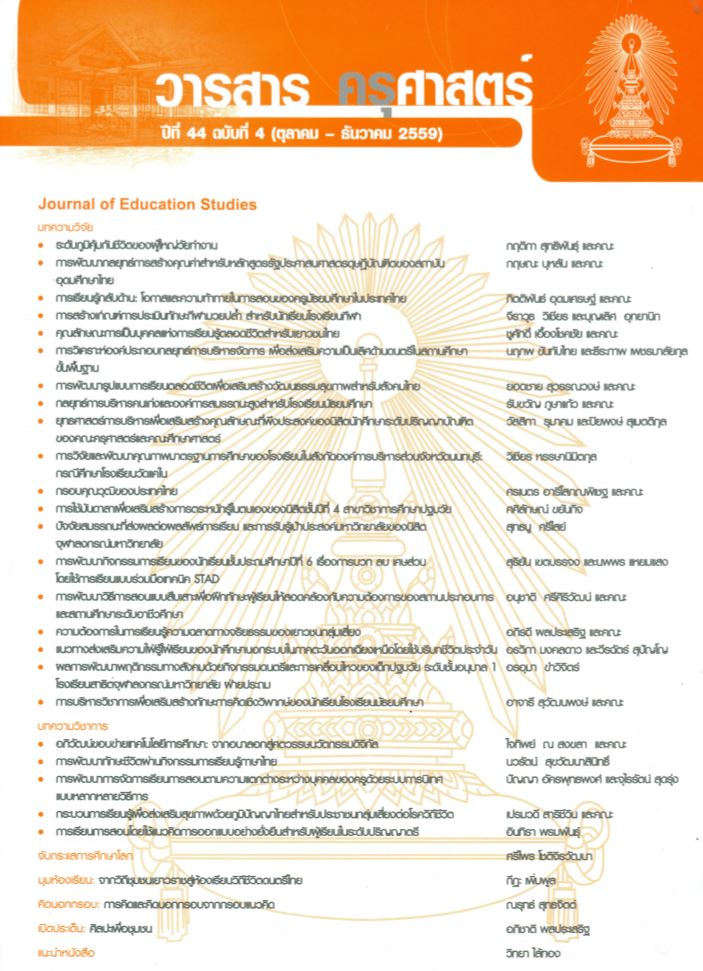การใช้มันดาลาเพื่อเสริมสร้างการตระหนักรู้ในตนเองของนิสิตชั้นปีที่ 4 สาขาวิชาการศึกษาปฐมวัย
Keywords:
มันดาลา, นิสิตสาขาวิชาการศึกษาปฐมวัย, การตระหนักรู้ในตนเอง, MANDALAS, STUDENTS IN EARLY CHILDHOOD DIVISION, SELF-AWARENESSAbstract
งานวิจัยนี้มีวัตถุประสงค์เพื่อศึกษาผลของการใช้มันดาลาต่อการตระหนักรู้ในตนเองของนิสิตชั้นปีที่ 4 สาขาวิชาการศึกษาปฐมวัย กลุ่มเป้าหมาย คือ นิสิตชั้นปีที่ 4 สาขาวิชาการศึกษาปฐมวัย ที่ลงทะเบียนเรียนรายวิชา 2717306 การประเมินและการส่งเสริมพัฒนาการและการเรียนรู้ของเด็กปฐมวัย ภาคการศึกษาต้น ปีการศึกษา 2557 จำนวนทั้งสิ้น 16 คน งานวิจัยนี้เป็นการวิจัยในชั้นเรียน โดยจัดให้นิสิตได้สร้างสรรค์มันดาลาทั้งเดี่ยว กลุ่มย่อย และกลุ่มใหญ่ จำนวนทั้งสิ้น 6 ครั้ง เก็บข้อมูลเชิงปริมาณก่อนและหลังการทดลองใช้มันดาลาโดยใช้แบบประเมินการตระหนักรู้ในตนเอง และเก็บข้อมูลเชิงคุณภาพโดยการสัมภาษณ์กลุ่มย่อยหลังการทดลองใช้มันดาลาร่วมกับการใช้ข้อมูลจากบันทึกสะท้อนประสบการณ์การเรียนรู้ของนิสิต วิเคราะห์ข้อมูลเชิงปริมาณโดยใช้การคำนวณหาค่าเฉลี่ยส่วนเบี่ยงเบนมาตรฐาน แล้วนำมาทดสอบค่าทีด้วยวิธีการเปรียบเทียบรายคู่ และวิเคราะห์ข้อมูลเชิงคุณภาพด้วยการวิเคราะห์เนื้อหา
ผลการวิจัยพบว่า 1) หลังการใช้มันดาลา นิสิตกลุ่มเป้าหมายมีค่าเฉลี่ยของคะแนนการตระหนักรู้ในตนเองสูงขึ้นอย่างมีนัยสำคัญทางสถิติที่ .05 2) นิสิตสะท้อนความคิดว่า มันดาลาทำให้ได้ทบทวนตนเอง ได้ฝึกฝนการสะท้อนตนเองนำไปสู่การตระหนักรู้ในตนเอง นิสิตสะท้อนความคิดว่า เกิดการตระหนักรู้ในตนเองในประเด็น การเห็นและยอมรับตนเอง และการรู้จักและเข้าใจผู้อื่น และ 3) นิสิตสะท้อนความคิดว่า มันดาลาทำให้เกิดการเข้าใจในประเด็นการประเมินพัฒนาการและการเรียนรู้ของเด็ก ได้แก่ การเท่าทันอคติของผู้ประเมิน การไม่รีบตัดสินข้อมูล การมีสติรู้ตัวการไม่ลำเอียงในการประเมิน และการยอมรับในความเป็นตัวตนของเด็ก
The objective of this research was to study the effects of using mandalas on the self-awareness of senior students in the early childhood education division. The sample comprised 16 senior students in the early childhood division enrolled in the 2717306 Assessment and Enhancement of Young Children’s Development and Learning Course, first semester of academic year 2014. This was action research which provided 6 weeks for senior students to create mandalas both individually and in groups. A self-awareness evaluation form was used at the beginning and the end of the course as quantitative data. While qualitative data were gathered using focus group interviews at the end of the course, and backing up with the reflective journal of each student. Quantitative data were analyzed using means, standard deviation, and matched paired t-test. Qualitative data were analyzed by using content analysis.
The findings were as follows: 1) After using mandalas, target students earned higher mean scores for self-awareness than before at the .05 significance level. 2) Senior students reflected that they had the opportunity to review their own experiences and practice self-reflection which leads to self-awareness. They reflected that they gained more awareness in the aspect of seeing and accepting themselves and understanding others. 3) They also reflected that they understood the concepts of assessing young children’s development and learning such as being aware of personal bias, being prolong of interpretation, being mindful, being fair in assessing, and respecting the child.




